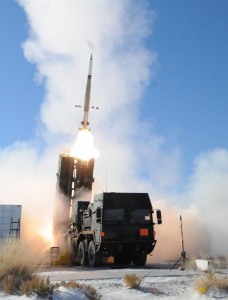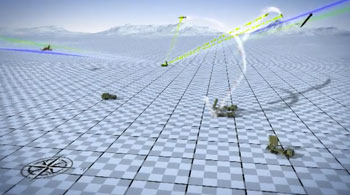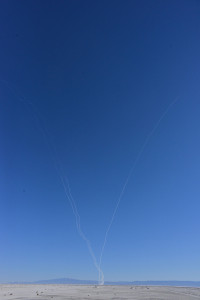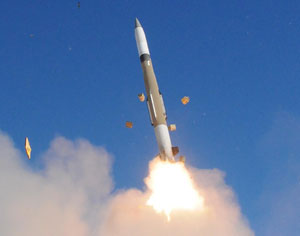
The Medium Extended Air Defense System (MEADS) has passed an important milestone today, intercepting and destroying two simultaneous targets attacking from opposite directions during a stressing demonstration of its 360-degree air and missile defense (AMD) capabilities at White Sands Missile Range, N.M. Accroding to preliminary report the flight test achieved all criteria for success. [ismember]The US and Germany are funding the MEADS development program with Italy, which remained the sole manufacturer of the program, after Washington and Berlin not to buy the system. The successful test will hopefully encourage international partners to join Italy in supporting the production and deployment of the new system.[/ismember]

The first target, a QF-4 air-breathing target, approached from the south as a Lance missile, flying a tactical ballistic missile trajectory, attacked from the north. The MEADS Surveillance Radar acquired both targets and provided target cues to the MEADS battle manager, which generated cue commands for the 360-degree MEADS Multifunction Fire Control Radar (MFCR). The MFCR tracked both targets successfully and guided missiles from launchers in the Italian and German configuration to successful intercepts. According to the plan, two missiles were launched at the ballistic missile target following ‘shoot-shoot’ protocol. A third interceptor was launched at the QF-4 target, demonstrating ‘over-the-shoulder’ maneuverability of the PAC-3 MSE Missile in engaging the targets.
“Today’s successful flight test is the culmination of three countries working together to design, develop and build the most advanced and capable air and missile defense weapon system in the world. No fielded ground-mobile AMD System can intercept targets from two directions at the same time, as MEADS did today,” said NATO MEADS Management Agency General Manager Gregory Kee. “MEADS technology can now be leveraged as mature, network-ready battle management, sensors and launchers to achieve the networked AMD capabilities envisioned by Germany, Italy and the United States.”
All elements of the MEADS system were tested, including the 360-degree MEADS Surveillance Radar, a networked MEADS battle manager, two lightweight launchers firing PAC-3 Missile Segment Enhancement (MSE) Missiles and a 360-degree MEADS Multifunction Fire Control Radar (MFCR). All system elements worked as planned.
The MEADS program is 3-for-3 in achieving flight test objectives. In November 2011, MEADS performed a simulated intercept of an air-breathing target. In November 2012, MEADS acquired, tracked and destroyed an MQM-107 target. Both tests demonstrated full-perimeter, 360-degree defense with the PAC-3 MSE Missile performing unique over-the-shoulder maneuvers to defeat targets attacking from behind the MEADS emplacement.

MEADS is a next-generation, ground-mobile AMD system that incorporates 360-degree radars, netted and distributed battle management, easily transportable launchers and the hit-to-kill PAC-3 MSE Missile. The MEADS program management agency NAMEADSMA is located in Huntsville, Ala. MEADS International, a multinational joint venture headquartered in Orlando, Fla., is the prime contractor for the MEADS system. Major subcontractors and joint venture partners are MBDA in Italy and Germany, and Lockheed Martin in the United States. “Based on the maturity of the MEADS hardware and software, we asked our customer to expand this test to a dual intercept,” said MEADS International President Dave Berganini. “The MEADS program continues to meet or exceed its commitments. Earlier this year, MEADS successfully demonstrated radar cueing, interoperability with networked NATO systems during Joint Project Optic Windmill (JPOW) and certification of our Mode 5 IFF system. Now we’re thrilled to demonstrate an unprecedented dual-intercept that has met test objectives and readies MEADS for further development and testing in Europe.”
MEADS was intended to provide the NATO replacement for the Patriot missiles, in service with Germany, Italy and the US. Unlike the Patriot covering a limited forward sector, MEADS offers hemispherical coverage and its range and missile kinematic performance are superior to that of the Patriot missile.
Unfortunately, the program fell victim to the budgetary cuts in 2011, as the Pentagon announced it will not fund the program beyond the development phase that is expected to complete in 2014. A German decision not to procure the system has followed the US announcement, leaving Italy as the only production sponsor of the program. Nevertheless, the National Armaments Directors of Germany, Italy, and the United States approved a contract amendment that funds two flight intercept tests, a launcher/missile characterization test, and a sensor characterization test before the MEADS Design and Development contract ends in 2014. The current test was part of that program.
Poland is reportedly interested in the MEADS partnership, as well as Japan. If no partners are be found, defense officials hope that some of the MEADS hardware will be used to field enhancements for the Patriot missile system, providing “minimum engagement capability.”

















